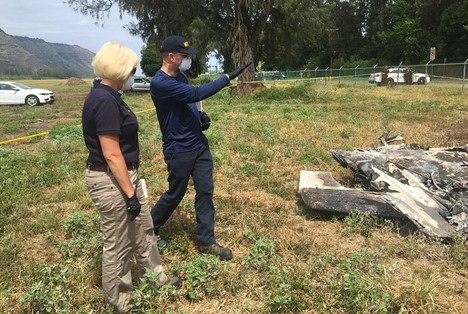WASHINGTON (April 13, 2021) — The National Transportation Safety Board detailed in an accident report issued Tuesday the circumstances that led to the June 21, 2019, crash of a parachute jump flight that killed all 11 people on board.
The NTSB determined that the probable cause of the accident was the pilot's aggressive takeoff maneuver, which led to an accelerated stall and a subsequent loss of control at an altitude too low for recovery. Safety issues found during this investigation were discussed at the March 23, 2021, public board meeting on Part 91 revenue passenger-carrying operations.
The twin-engine Beech King Air 65-A90 airplane, which was operated by Oahu Parachute Center, crashed adjacent to the runway shortly after departing Dillingham Airfield in Mokuleia, Hawaii, with one pilot and 10 passengers aboard.

(In this photo, taken on June 23, 2019, NTSB Investigator-in-Charge Eliott Simpson and Board Member Jennifer Homendy examine wreckage at the scene of the Mokuleia, Hawaii, June 21, 2019, crash of a Beech 65-A90. The airplane crashed shortly after departing Dillingham Airfield for a parachute jump flight. NTSB photo by Eric Weiss.)
The airplane was involved in a stall/spin accident in 2016 during a parachute jump flight in California while it was operated by another company and flown by another pilot. Although no one was injured during the aerodynamic stall and subsequent series of spins, the plane shed parts and a wing was twisted during the inflight recovery.
During the investigation of the June 2019 crash, NTSB investigators discovered the twisted left wing, from the 2016 incident, was not repaired, leaving the airplane in an unairworthy condition. The NTSB said the damage reduced the left wing's stall margin and could cause the airplane to roll left in certain flight conditions. The NTSB said the failure of Oahu Parachute Center and its contract mechanic to maintain the airplane in an airworthy condition contributed to the accident.
Investigators found the pilot's flight instructor provided substandard initial instruction, and that Oahu Parachute Center provided insufficient training in the operation of the airplane. Although the pilot was properly certificated to fly the accident airplane, investigators said his lack of adequate training and experience in the handling qualities of the airplane in particular flight conditions contributed to the accident. The NTSB detailed these deficiencies in the report and issued a series of safety recommendations in January to address this safety issue.
The NTSB noted the Federal Aviation Administration did perform inspections of Oahu Parachute Center, but those inspections, which failed to identify the damaged left wing of the accident airplane, were insufficient to ensure the safety of that commercial passenger-carrying operation.
The FAA's insufficient regulatory framework for overseeing parachute jump operations was discussed in the NTSB's report, Enhance Safety of Revenue Passenger-Carrying Operations Conducted Under Title 14 Code of Federal Regulations Part 91. In that report, the NTSB issued a recommendation to the FAA to develop a new regulatory framework for these operations, which include parachute jump flights.
The full accident report, Collision with Terrain During Takeoff of Parachute Jump Flight, Beech King Air 65-A90, Mokuleia, Hawaii, June 21, 2019, is available online at https://go.usa.gov/xHbt8.
Enhance Safety of Revenue Passenger-Carrying Operations Conducted Under Title 14 Code of Federal Regulations Part 91 is available online at https://go.usa.gov/xHbMj.
To report an incident/accident or if you are a public safety agency, please call 1-844-373-9922 or 202-314-6290 to speak to a Watch Officer at the NTSB Response Operations Center (ROC) in Washington, DC (24/7).